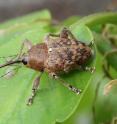Bugs collected on rooftop for 18 years reveal climate change effects
A volunteer registration of insects for 18 consecutive years on the Copenhagen roof of the Natural History Museum of Denmark has revealed local insect community turnover due to climate change. The research suggests a pattern of specialised species being more sensitive to climate change. 1543 different species of moths and beetles and more than 250.000 individuals have been registered on a single urban rooftop in Copenhagen over 18 years of monitoring. That corresponds to 42 % of all the species of moths in Denmark and 12 % of the beetles. More interestingly, the insect community has changed significantly during that period. The results are published today in the Journal of Animal Ecology led by researchers from the Center for Geogenetics and the Center for Macroecology, Evolution and Climate at the Natural History Museum of Denmark at the University of Copenhagen.
"As temperature increases we see a corresponding change in the insect community, specifically for the resource specialists - the insects that feed on only one species of plant. Earlier studies have confirmed that specialist species also respond rapidly to destruction of their habitats, so we are dealing with a very sensitive group of animals" says one of the lead authors postdoc Philip Francis Thomsen from the Center for Geogenetics.
The nut weevil (Curculio nucum) is an example of a resource specialist, feeding only on hazel. It lives further north in Europe than its close relative the acorn weevil (Curculio glandium), which feeds only on acorns. While the nut weevil was only registered in the first half of the study, the acorn weevil only appeared in the last part of the study, suggesting that specialist species are moving northwards in Europe. Using the entire dataset, the study was able to confirm this trend and highlights the increased pressure on the most northern species, which may be 'squeezed out' of their range in the long term.
"We are likely to lose some specialist species as they retreat north, but more new specialist species will arrive from the south. This trend is theoretically expected but extremely rare to confirm with observations across this many species. Insects are often over-looked and under prioritised for long term studies" says the other lead author Peter Søgaard Jørgensen, PhD from the Center for Macroecology, Evolution and Climate.
It was two employees from the Natural History Museum of Denmark with extensive entomological expertise, Ole Karsholt and Jan Pedersen, who collected and identified all the insects. The monitoring took place every week from 1992 to 2009 through spring, summer and autumn using a light trap at the roof of the museum at 17.5 meters height. What started out as a hobby based on scientific curiosity, ended up in an extensive faunal and climate change study.
"Long-term monitoring, even without a pre-defined purpose, can be of incredible value when trying to understand and predict biodiversity in a changing world. Species monitoring is under prioritised in Denmark and primarily driven by personal interest from committed enthusiasts. Without those individuals we would basically be in the dark about the majority of species in Denmark. The same is probably true for many other European countries. We hope this study can push nature monitoring back onto the political agenda" says Philip Francis Thomsen.
Seven species of moths and two species of beetles were registered for the first time in Denmark by Karsholt and Pedersen, including the multicolored Asian lady beetle (Harmonia axyridis), which has since spread to most of the country and is now considered invasive. Also species living in habitats at least 10 km away were registered as well as some migrating moths from countries south of Denmark.
"Some insects are very mobile and only eat as larvae. It is therefore not unusual to find them further from their habitats as adults. However, it is an impressive diversity of species registered. Even though the study is limited to one site, there is no reason to believe that the trend we see here would be different at other sites" says Peter Søgaard Jørgensen.
For each group of species, the scientists calculated an index for the temperature related change across their entire habitat range in Europe for the study period. The specialist moth species experienced an increase of 0.14 °C between 1993 and 2008 and the specialist beetle species 0.42 °C between 1995 and 2008.
"The results confirm that climate change is impacting biodiversity right now. It is not something that will happen far into the future or only if we reach a two degree temperature increase" says Peter Søgaard Jørgensen.
Source: Faculty of Science - University of Copenhagen
Articles on the same topic
Other sources
- Bugs collected on rooftop for 18 years reveal climate change effectsfrom Physorg9 years ago
- Some like it hot: Moth and butterfly species respond differently to climate changefrom Science Daily9 years ago
- Some like it hot: Moth and butterfly species respond differently to climate changefrom Physorg9 years ago



